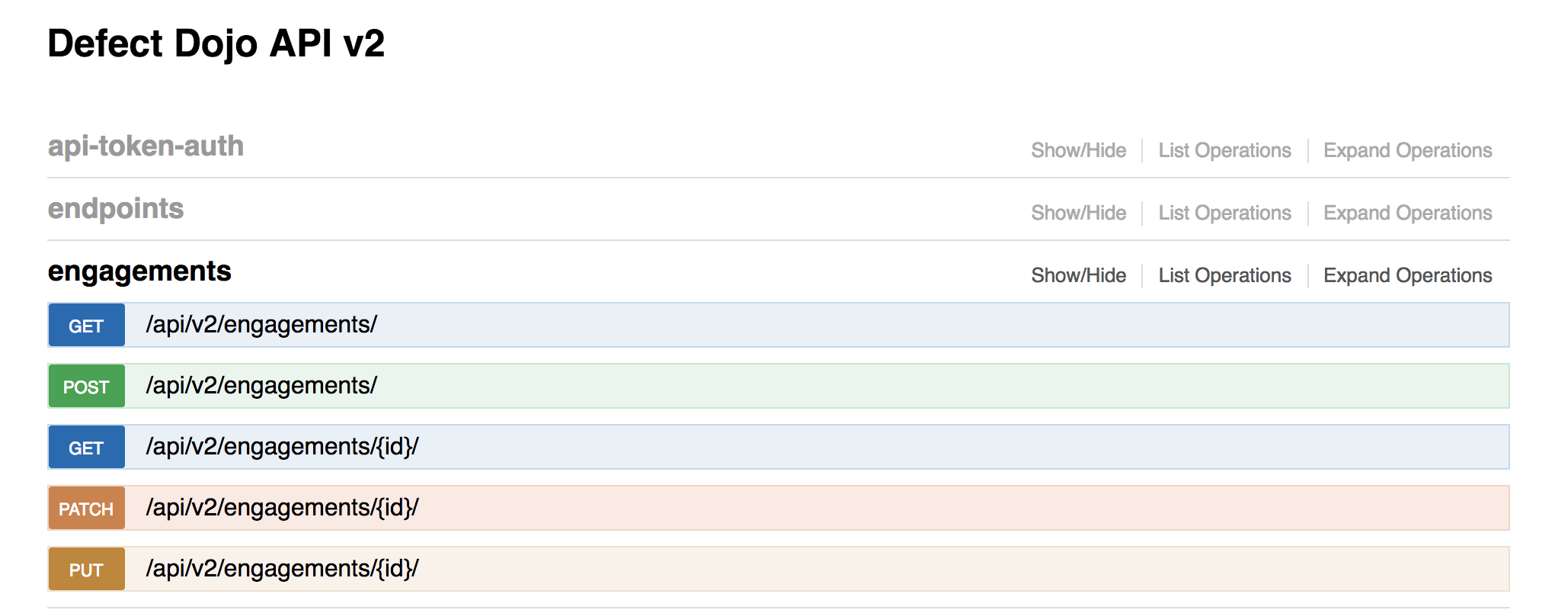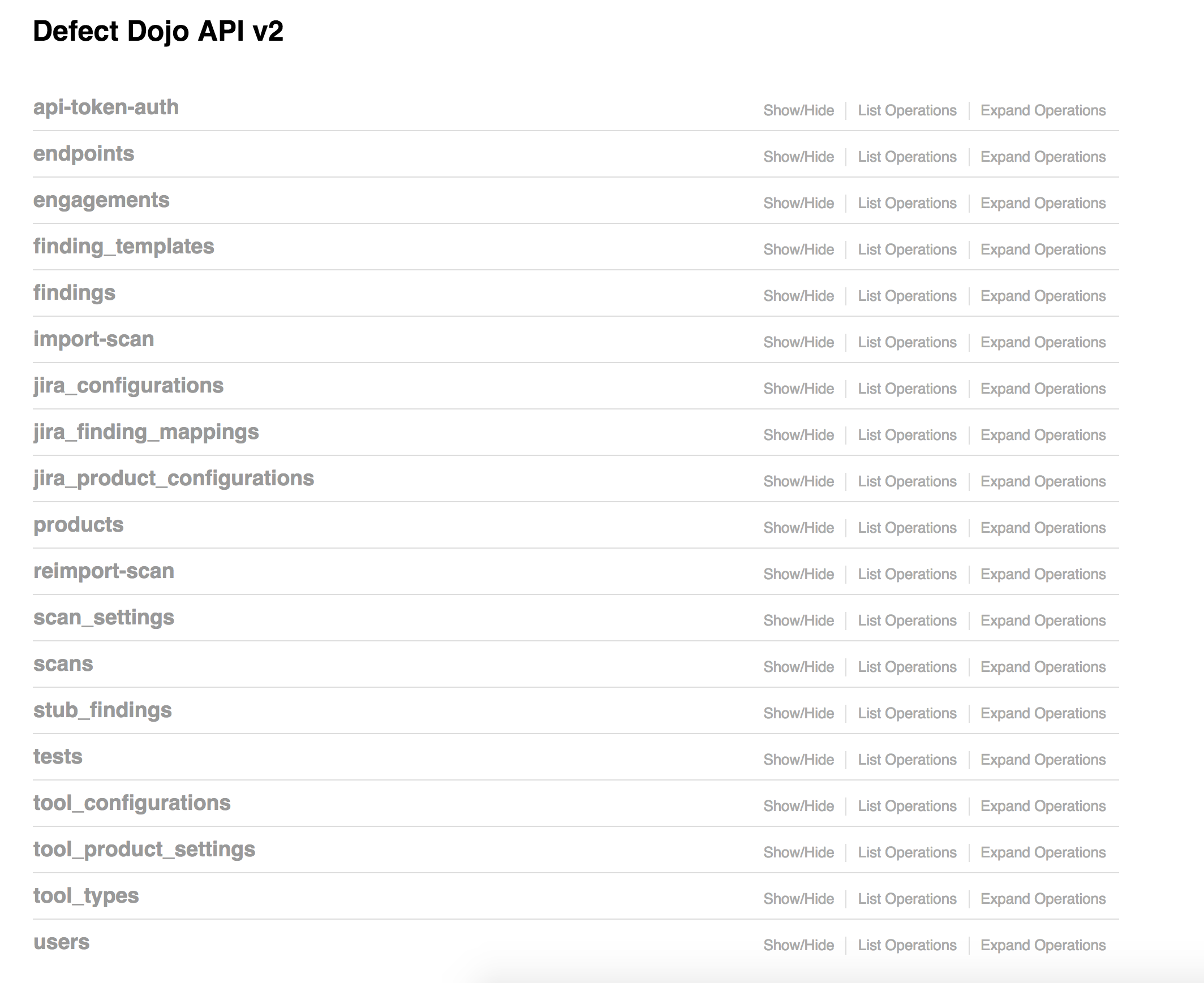DefectDojo API v2
DefectDojo's API is created using Django Rest
Framework. The documentation of
each endpoint is available within each DefectDojo installation at
/api/v2/doc/ and can be accessed by choosing the API v2
Docs link on the user drop down menu in the header.

The documentation is generated using drf-spectacular at /api/v2/oa3/swagger-ui/, and is
interactive. On the top of API v2 docs is a link that generates an OpenAPI v3 spec.
To interact with the documentation, a valid Authorization header value
is needed. Visit the /api/key-v2 view to generate your
API Key (Token <api_key>) and copy the header value provided.

Each section allows you to make calls to the API and view the Request URL, Response Body, Response Code and Response Headers.

If you’re logged in to the Defect Dojo web UI, you do not need to provide the authorization token.
Authentication
The API uses header authentication with API key. The format of the header should be: :
Authorization: Token <api.key>
For example: :
Authorization: Token c8572a5adf107a693aa6c72584da31f4d1f1dcff
Alternative authentication method
If you use an alternative authentication method for users, you may want to disable DefectDojo API tokens because it could bypass your authentication concept.
Using of DefectDojo API tokens can be disabled by specifying the environment variable DD_API_TOKENS_ENABLED to False.
Or only api/v2/api-token-auth/ endpoint can be disabled by setting DD_API_TOKEN_AUTH_ENDPOINT_ENABLED to False.
Sample Code
Here are some simple python examples and their results produced against
the /users endpoint: :
import requests
url = 'http://127.0.0.1:8000/api/v2/users'
headers = {'content-type': 'application/json',
'Authorization': 'Token c8572a5adf107a693aa6c72584da31f4d1f1dcff'}
r = requests.get(url, headers=headers, verify=True) # set verify to False if ssl cert is self-signed
for key, value in r.__dict__.items():
print(f"'{key}': '{value}'")
print('------------------')This code will return the list of all the users defined in DefectDojo. The json object result looks like : :
[
{
"first_name": "Tyagi",
"id": 22,
"last_login": "2019-06-18T08:05:51.925743",
"last_name": "Paz",
"username": "dev7958"
},
{
"first_name": "saurabh",
"id": 31,
"last_login": "2019-06-06T11:44:32.533035",
"last_name": "",
"username": "saurabh.paz"
}
]Here is another example against the /users endpoint, this
time we will filter the results to include only the users whose user
name includes jay:
import requests
url = 'http://127.0.0.1:8000/api/v2/users/?username__contains=jay'
headers = {'content-type': 'application/json',
'Authorization': 'Token c8572a5adf107a693aa6c72584da31f4d1f1dcff'}
r = requests.get(url, headers=headers, verify=True) # set verify to False if ssl cert is self-signed
for key, value in r.__dict__.items():
print(f"'{key}': '{value}'")
print('------------------')The json object result is: :
[
{
"first_name": "Jay",
"id": 22,
"last_login": "2015-10-28T08:05:51.925743",
"last_name": "Paz",
"username": "jay7958"
},
{
"first_name": "",
"id": 31,
"last_login": "2015-10-13T11:44:32.533035",
"last_name": "",
"username": "jay.paz"
}
]See Django Rest Framework's documentation on interacting with an API for additional examples and tips.
Manually calling the API
Tools like Postman can be used for testing the API.
Example for importing a scan result:
Verb: POST
Headers tab:
- add the authentication header
- Key: Authorization
- Value: Token c8572a5adf107a693aa6c72584da31f4d1f1dcff
Body tab
- select "form-data", click "bulk edit". Example for a ZAP scan:
engagement:3
verified:true
active:true
lead:1
tags:test
scan_type:ZAP Scan
minimum_severity:Info
skip_duplicates:true
close_old_findings:false
Body tab
- Click "Key-value" edit
- Add a "file" parameter of type "file". This will trigger multi-part form data for sending the file content
- Browse for the file to upload
Click send
Clients / API Wrappers
| Wrapper | Status | Notes |
|---|---|---|
| Specific python wrapper | working (2021-01-21) | API Wrapper including scripts for continous CI/CD uploading. Is lagging behind a bit on latest API features as we plan to revamp the API wrapper |
| Openapi python wrapper | proof of concept only where we found out the the OpenAPI spec is not perfect yet | |
| Java library | working (2021-08-30) | Created by the kind people of SecureCodeBox |
| Image using the Java library | working (2021-08-30) | |
| .Net/C# library | working (2021-06-08) | |
| dd-import | working (2021-08-24) | dd-import is not directly an API wrapper. It offers some convenience functions to make it easier to import findings and language data from CI/CD pipelines. |
Some of the api wrappers contain quite a bit of logic to ease scanning and importing in CI/CD environments. We are in the process of simplifying this by making the DefectDojo API smarter (so api wrappers / script can be dumber).